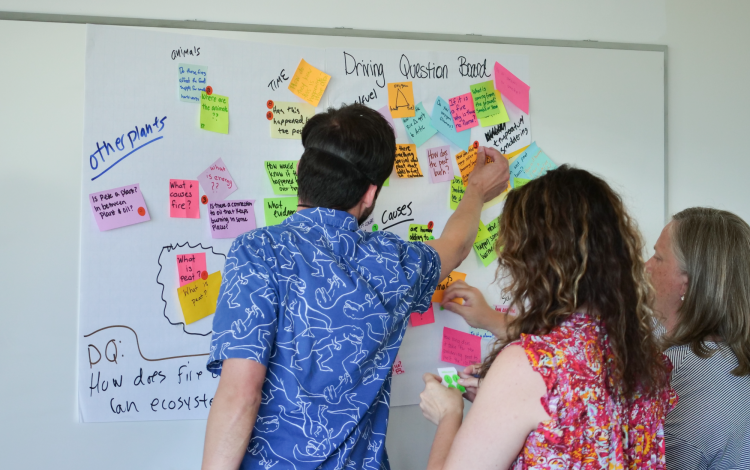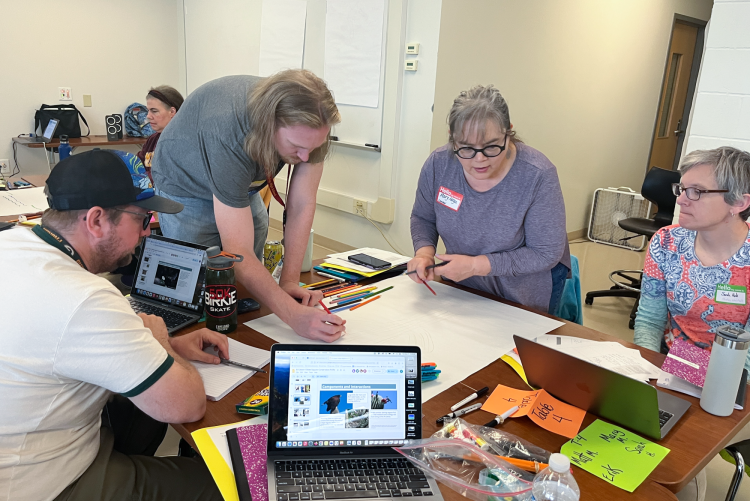Student curiosity drives new open-source science curricula
Banner image: "Drivinq questions" boards, such as this one featuring burning questions about Arctic wildfires, sit at the heart of new, three-year science curricula. (Credit: inquiryHub)
A coalition of educators from 10 states and led by CU Boulder has released a new series of free science curricula for high school students—touching on issues critical to the lives of young people, from wildfires to rising sea levels and cancer biology.
The new curricula, called OpenSciEd High School, is a three-year high school science program designed by a consortium of developers led by the inquiryHub, a research-practice partnership based at CU Boulder. The ambitious curriculum project reflects the collaborative efforts of the OpenSciEd High School Developer’s Consortium, which also includes Northwestern University, BSCS Science Learning, the Dana Center at the University of Texas Austin and Denver Public Schools. Ann Rivet of Columbia University led the integration of Earth and space science in the curricula.
Any teacher or school across the United States can download these materials at no cost, said William Penuel, who led the $7 million project.
“This project has been a partnership of unprecedented scale in the development of high-quality instructional materials in science,” said Penuel, distinguished professor in the Institute of Cognitive Science (ICS) and School of Education at CU Boulder. “It’s also been a partnership that has kept its eyes always on the prize of giving all high school students the opportunity to experience science as relevant to their lives and as an important resource for improving their communities.”
Penuel noted that the curricula take a new approach to teaching about science—giving kids opportunities to get their hands dirty (in some cases literally) and ask and answer their own questions about the natural world.
High school students, for example, might shine heat lamps on pieces of construction paper to learn how ice of different colors melt at different speeds in the Arctic. They may create static electricity by rubbing balloons on various objects to understand why lightning strikes in some places around the world and not others. They might also crush pieces of foam together to simulate how the motion of tectonic plates gives rise to mountain ranges like the Rockies.
OpenSciEd High School was guided by the non-profit organization OpenSciEd with support from the Bill & Melinda Gates Foundation, Carnegie Corporation of New York, Walton Family Foundation and William and Flora Hewlett Foundation. The Consortium’s curriculum development also benefited from input from a 10-state steering committee, the Learning in Places group, and Science Educators for Equity, Diversity, and Social Justice.
Kate Henson, director of K-12 STEM teaching and learning at inquiryHub, said the team designed its materials with real teachers and students from 310 schools.
“They’re designed for teachers by teachers,” Henson said. “These are people who understand the demands of the classroom. They understand the scaffolds and support that students need.”
Driving questions
Henson added that, in many cases, traditional curricula treat science as a set of facts that students need to memorize. OpenSciEd High School hinges on a student’s own curiosity.
Take, for example, one biology unit focusing on the spread of wildfires around the world. Students begin by hearing about an ecological puzzle: In some parts of the Arctic, “zombie” fires can form in the carbon-rich soil below ice. Students may wonder: What’s in the smoke from those zombie fires? Where do the fires get oxygen to burn? They write their questions down on what Henson and her colleagues call a “driving questions board”—then spend the next several weeks answering them.
“The whole instructional model has a storyline that is designed to make the learning coherent from the student perspective,” Henson said.
Developing the curricula took years of hard work.
First, inquiryHub researchers surveyed real high school students, including many from communities underrepresented in the sciences, about the topics they most wanted to learn about. Then the group worked with education researchers, high school teachers, school district administrators and more to design the curricula. Finally, the team field tested the lessons in classrooms serving roughly 19,000 students. The curricula align with the Next Generation Science Standards, a set of standards that guide science education in states across the country, including Colorado.
The inquiryHub group also offers a range of professional development resources to guide teachers through implementing this new way of teaching science.
The team hopes the curricula will help provide all high school students, no matter their backgrounds, access to a high-quality science education and give them tools to begin solving issues facing their own communities.
“These are for everybody,” Henson said. “And they’re all free, so teachers are able to adapt them to their own local contexts.”




